Vintage lingerie evokes both an era and what society valued during that era. Posture, propriety, pleasure, movement. From the stiff, swan-backed lines of the 1900s to the sculpted lift of mid-century Hollywood, underpinnings track every turn in fashion, work, and technology. And yes, modern play has a place in that story too. Today’s novelty sets and themed looks, from silk slips to cheeky animal lingerie, are simply another way the drawer reflects mood and imagination.
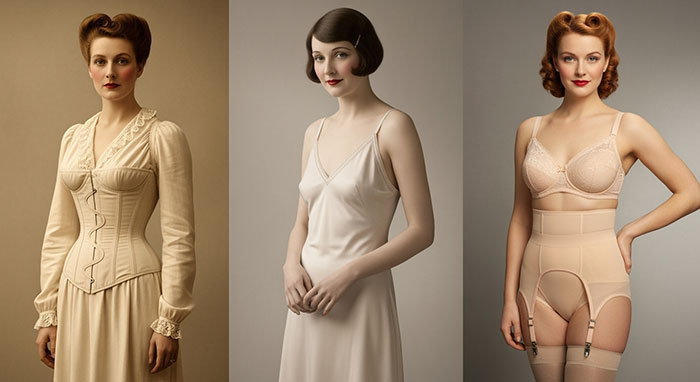
The route from bone and laces to elastic and precision cups isn’t tidy. It zigzags with new fibers, wartime shortages, and changing hemlines. Through it all, one arc stands out: control loosens, comfort rises, and design starts working with the body instead of against it.
Edwardian beginnings: the S-bend silhouette
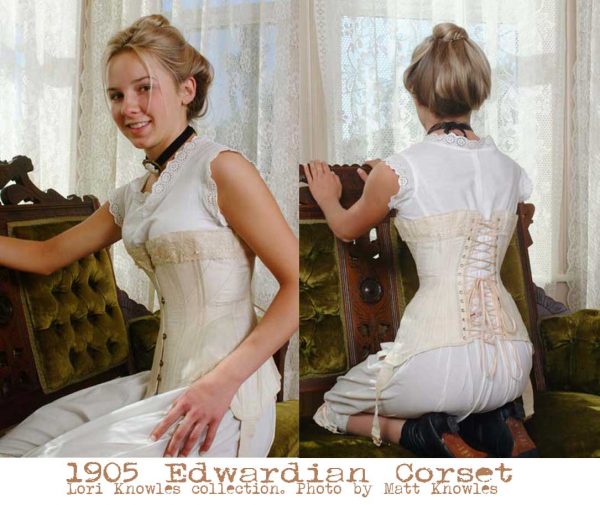
Around 1900, the S-bend corset sets the tone. It tilts the torso forward and the hips back, creating that elegant “sway” under frothy blouses and sweeping skirts. Materials are stern, whalebone or steel boning stitched into coutil and cotton. A chemise and split drawers protect clothing; the corset shapes everything else. Movement rates second to form. Still, pressure builds for change. Doctors warn about compressed ribs; dress reformers argue for air and ease. The idea is planted: beauty shouldn’t require bruises.
1910s: the brassiere steps in
Silhouettes slim as skirts narrow and waistlines climb. Corsets drop lower on the abdomen; the torso straightens. Work and war push practicality. A key shift lands: the bra, patented in the 1910s, separates bust support from waist control. Adoption is uneven at first, but the seed takes. Fabrics diversify, mercerized cotton, silk, and early artificial fibers feel lighter, smoother, and kinder on skin. The body starts breathing again.
1920s: the flat, fast decade

Cue the Jazz Age. Fashion favors a boyish line and the freedom to dance. Vintage lingerie trims down: bandeau bras and step-ins mute curves; chemise slips in silk or rayon skim the body. Tap pants arrive, cut generously for the Charleston. Garters keep stockings in place as skirts lift. The goal isn’t lift or cinch, it’s a clean, straight canvas under beading and fringe. Structure bows to speed and mood.
1930s: shape returns, with brains
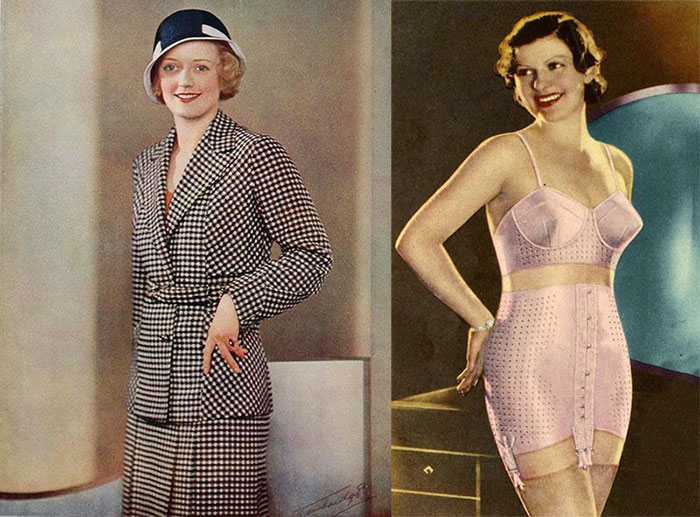
Curves come back as bias-cut gowns cling and drape. Underneath, engineering levels up. Cup concepts mature; sizing begins to standardize. Girdles replace rigid corsets for many, powered by Lastex and new elastic yarns that stretch and spring back. Slips are mapped to vanish under bias seams, hugging without grabbing. The big upgrade isn’t just look, it’s feel. Support gets smarter, more negotiated. The garment shapes, the wearer moves, both win.
1940s: rationing grit and nylon dreams
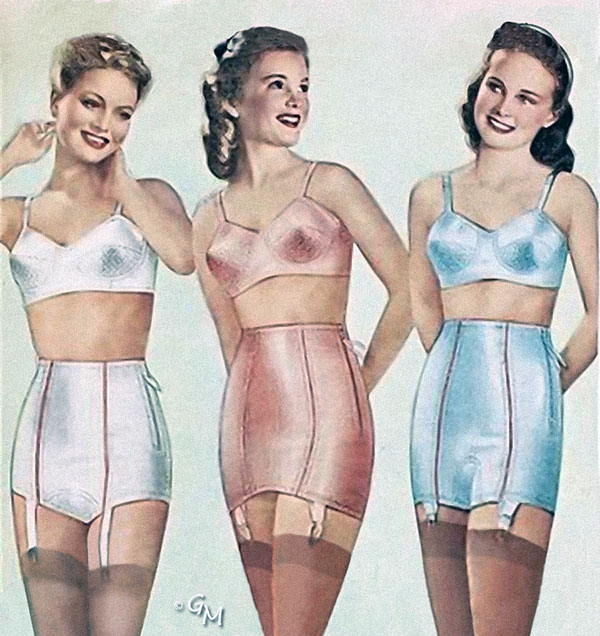
War shuffles everything. Silk and nylon go scarce; stockings become mythic. Lingerie pares to utility, durable cottons, careful mending, a make-do spirit. Some draw stocking seams with eyeliner; others swap, barter, patch. But technology quietly keeps improving. Elastic quality rises, patterns refine, comfort sneaks forward even in lean times. When peace returns, nylon surges back, shiny, quick-dry, irresistible. Drawers refill with lighter bras, slips, and panties that wash on a weeknight and wear the next morning.
1950s: hourglass ambition and the bullet bra
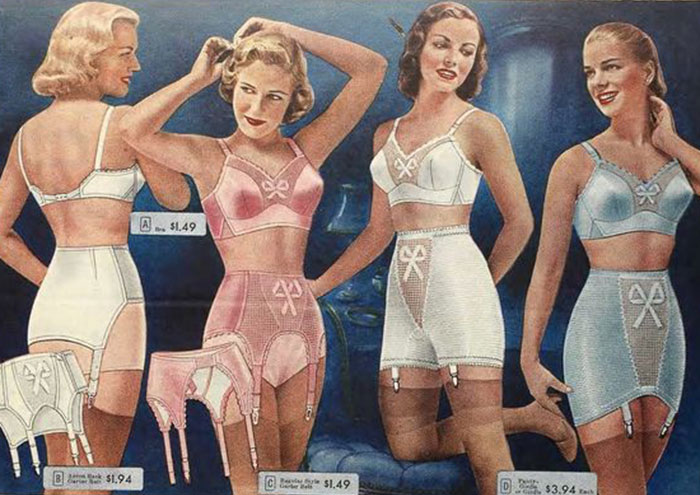
Mid-century glamour sets a precise target: small waist, lifted bust, neat hips. Lingerie obliges with confidence. The bullet bra, stitched concentric cups, firm support, often a little foam, makes the “sweater girl” silhouette unmistakable. Cup letters and band sizes settle into a shared language; closures get more refined; comfort doesn’t have to look plain. Girdles and waspies cinch without hour-long lacing sessions. Nylon, acetate, and elastic blends dominate, brightened by lace and ribbon because utility no longer runs the show. Style does.
More than any single piece, attitude transforms. Underpinnings stop pretending they’re invisible. Ads wink. Pin-up culture puts lingerie in the spotlight. A set can be practical at noon and charming by night, and no one finds the dual role confusing.
Three quiet revolutions behind the seams
Materials: From bone and steel to rubberized threads, nylon, and resilient blends, the fabric mix shifts from rigid to responsive. Garments recover their shape instead of crumpling, breathe instead of trapping heat, and weigh a fraction of their ancestors.
Fit: The corset commands; the 1930s girdle negotiates; the 1950s bra collaborates. Support grows targeted, by cup, band, paneling, so shaping doesn’t demand surrender.
Intent: Lingerie evolves from shield to style tool. It hides lines when needed, enhances curves when wanted, and, increasingly, expresses mood. Basics coexist with ornament. Function shakes hands with theater.
Lingerie echoes that still matter
The Edwardian love for upright posture echoes in modern longline bras and structured basques. The 1920s ease shows up in slinky silk slips that glide under knit dresses. The 1930s obsession with bias and drape reappears every time a slip dress skims the runway. And the 1950s gift, technical cups with precise support, anchors most everyday bras, even the seamless ones.
That’s why a present-day drawer looks happily mixed. A smooth T-shirt bra sits beside a retro longline. High-waist briefs stack next to whisper-thin bikinis. And playful sets, animal prints, ears, tails, tongue-in-cheek trims, claim their corner because fantasy is part of modern expression, not a sideshow. Choice is the throughline.
What changed the most? Movement
If one thread ties the decades together, it’s the right to move, through a workday, through a dance, through weather and worry, without pain. As fabric tech solves problems (stretch, recovery, breathability), lingerie drops the job of restraint and picks up the job of partnership. That partnership isn’t shy. It shapes where asked, disappears when needed, and steps into the spotlight when invited.
The takeaway
From the S-bend corset to the bullet bra, vintage lingerie’s evolution from the Edwardian era through the 1950s maps a culture learning to balance beauty and ease. Each decade loosens the screws a little, less pressure, more intelligence, better fabric, bolder intent. That legacy indicates up in the whole lot worn today, from ordinary seamless fundamentals to unfashionable silhouettes and playful gown pieces. Underpinnings aren`t simply under, they steer the outfit, set the mood, and, at their best, allow the frame breathe at the same time as the fashion speaks.
That’s all ! © Glamourdaze
